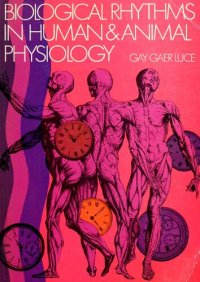
Ebook: Biological Rhythms in Human and Animal Physiology
Author: Gay Gaer Luce
- Genre: Biology // Anthropology
- Tags: biological rhythms
- Year: 1971
- Publisher: Dover Publications
- City: New York
- Language: English
- pdf
Deaths due to hardening of the arteries peak in the month of January. A normal man will breathe mainly through one nostril for three hours, then the other for three hours. Worms and snails tend to move in given compass directions at certain times of the day, month and year. People estimate time as passing faster when their body temperatures are higher. There are more suicides in May than-in any other month. The metabolism of crabs corresponds to daily fluctuations in cosmic radiation. Normal men go through emotional cycles suggestive of the menstrual cycle in women. The eyes of crayfish turn light every 12 hours, even in constant darkness. Cancer cells proliferate in a tempo that differs from that of the rest of the body.
These are just a few of the tremendously interesting and scientifically significant facts discovered in one of the newest and most fruitful fields of biological study, that of rhythms affecting organisms. The book now in your hands, published in 1970, could not even have been written ten years ago; yet it encompasses the results of well over 650 scientific investigations, almost all within the last decade.
The results show that man, along with the rest of the animal and plant worlds, indeed feels, grows, acts and reacts in time to various rhythms, the most common being the 24-hour solar day (but the activity of crabs is in time to the lunar day, 24.8 hours). Hundreds of experiments and observations are cited in this book, a survey of everything we know about biological rhythms as of 1970. The effects of isolation from day-night patterns, of illnesses, psychoses and drugs; extensive investigations of sleep and dreaming; rhythms underlying our sensory perceptions, eating, formation and repair of tissues, production of hormones and other bodily chemicals, urination, work performance, emotion, memory and learning; susceptibility to illness; seasonal variations; pain tolerance; effects of light and dark and of jet travel; working schedules and cave studies; effects of electric fields, magnetism and even sun spots—all and more are covered in this absorbing and scientifically precise treatment.
Prepared for the National Institute of Mental Health, this survey is certain to be of engrossing interest to anyone in the least concerned with psychology, physiology, research medicine, zoology or biochemistry—whether scientist or layman. No technical background is necessary; the material is presented in ordinary English and easily read style.
These are just a few of the tremendously interesting and scientifically significant facts discovered in one of the newest and most fruitful fields of biological study, that of rhythms affecting organisms. The book now in your hands, published in 1970, could not even have been written ten years ago; yet it encompasses the results of well over 650 scientific investigations, almost all within the last decade.
The results show that man, along with the rest of the animal and plant worlds, indeed feels, grows, acts and reacts in time to various rhythms, the most common being the 24-hour solar day (but the activity of crabs is in time to the lunar day, 24.8 hours). Hundreds of experiments and observations are cited in this book, a survey of everything we know about biological rhythms as of 1970. The effects of isolation from day-night patterns, of illnesses, psychoses and drugs; extensive investigations of sleep and dreaming; rhythms underlying our sensory perceptions, eating, formation and repair of tissues, production of hormones and other bodily chemicals, urination, work performance, emotion, memory and learning; susceptibility to illness; seasonal variations; pain tolerance; effects of light and dark and of jet travel; working schedules and cave studies; effects of electric fields, magnetism and even sun spots—all and more are covered in this absorbing and scientifically precise treatment.
Prepared for the National Institute of Mental Health, this survey is certain to be of engrossing interest to anyone in the least concerned with psychology, physiology, research medicine, zoology or biochemistry—whether scientist or layman. No technical background is necessary; the material is presented in ordinary English and easily read style.
Download the book Biological Rhythms in Human and Animal Physiology for free or read online
Continue reading on any device:

Last viewed books
Related books
{related-news}
Comments (0)